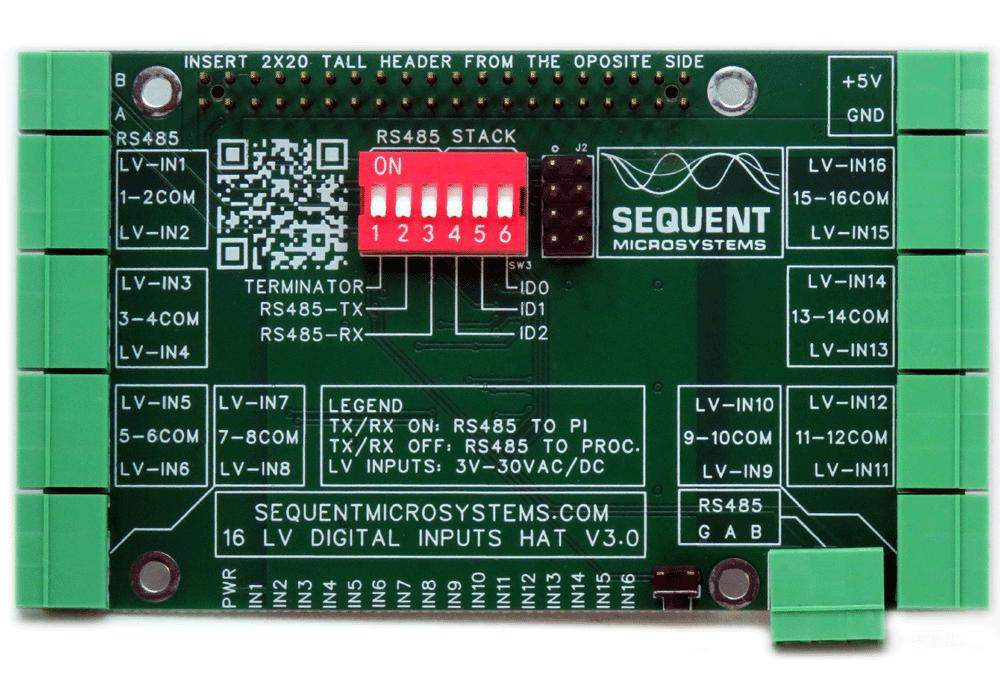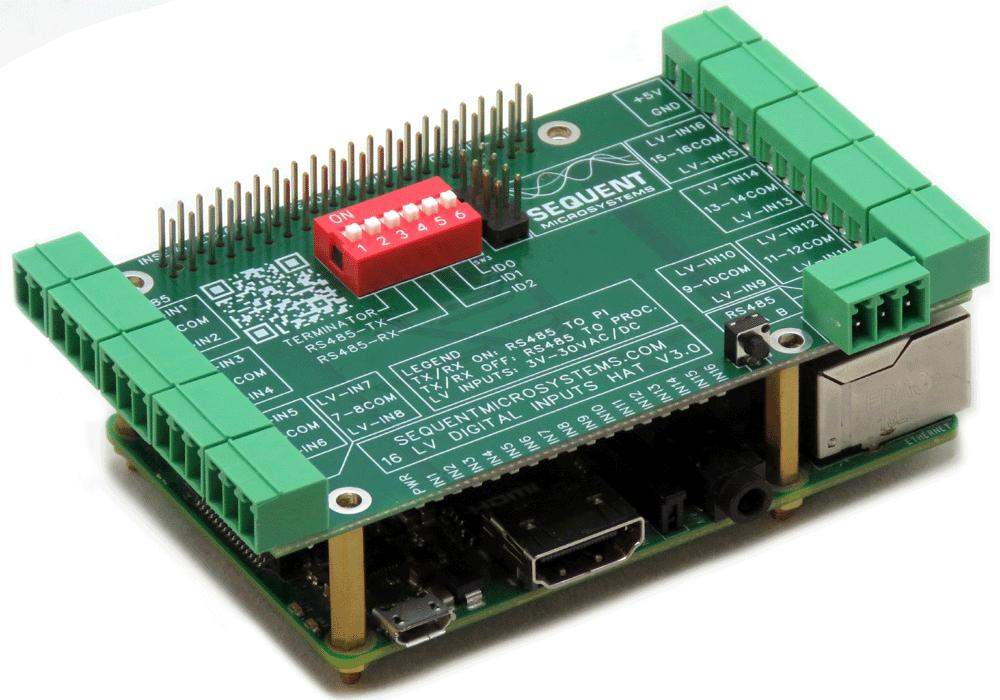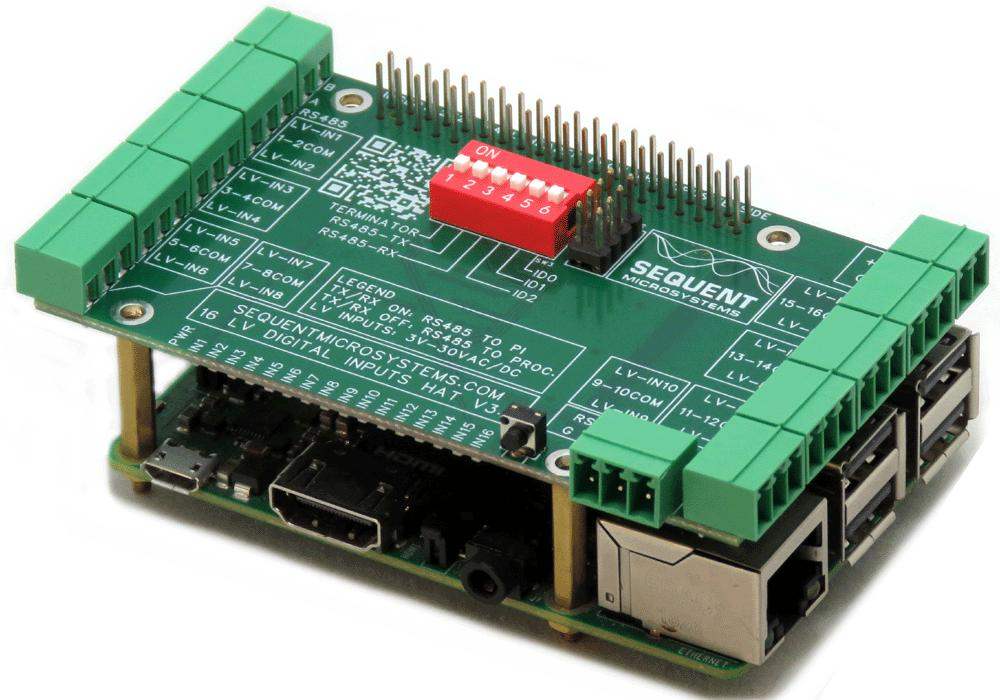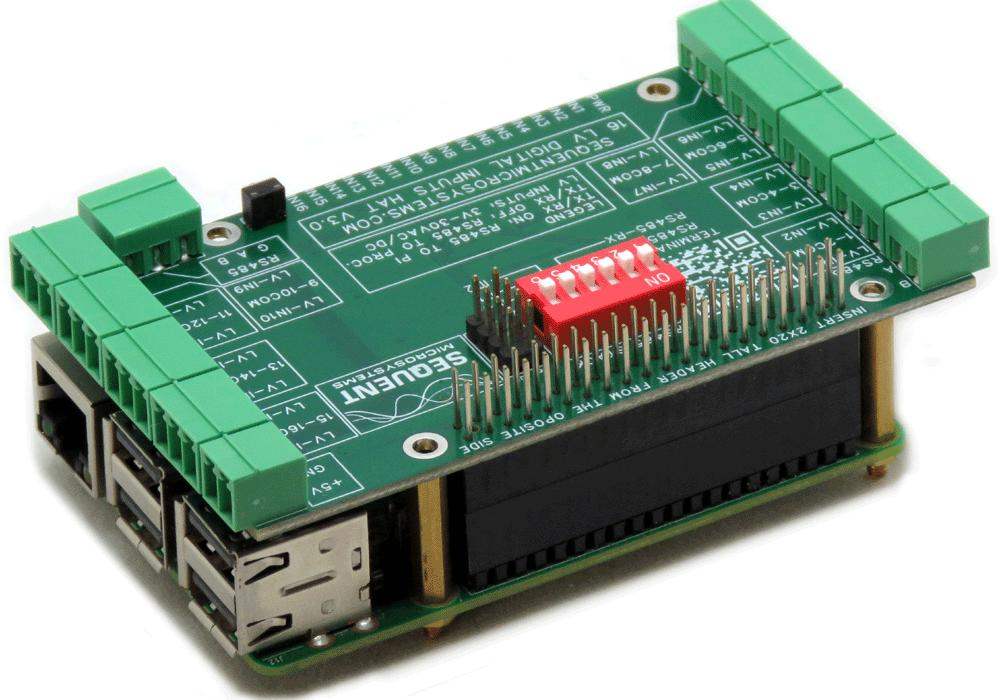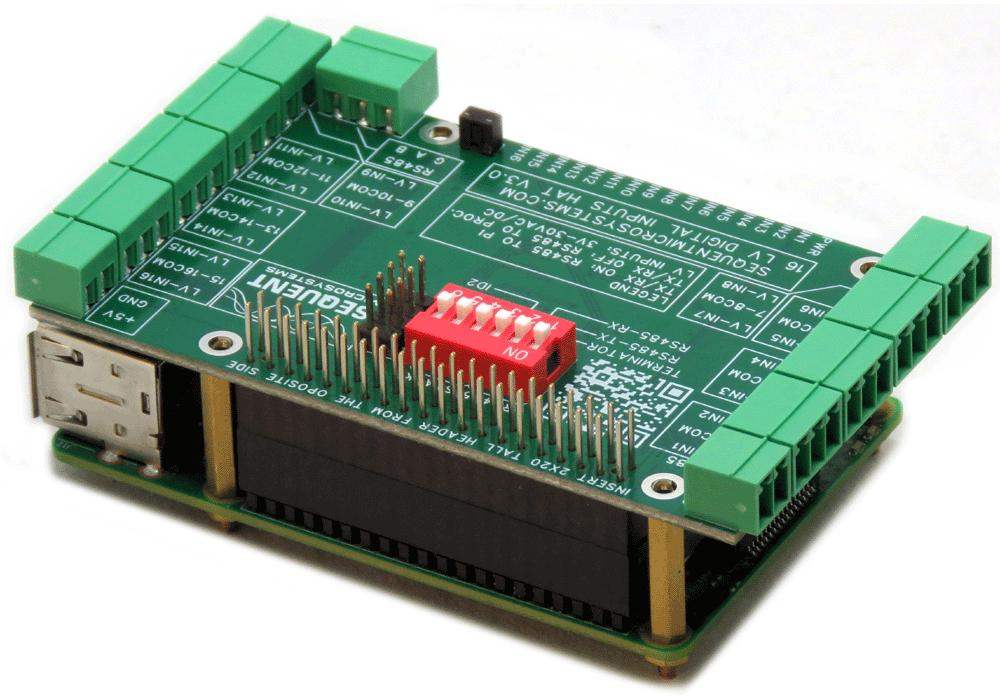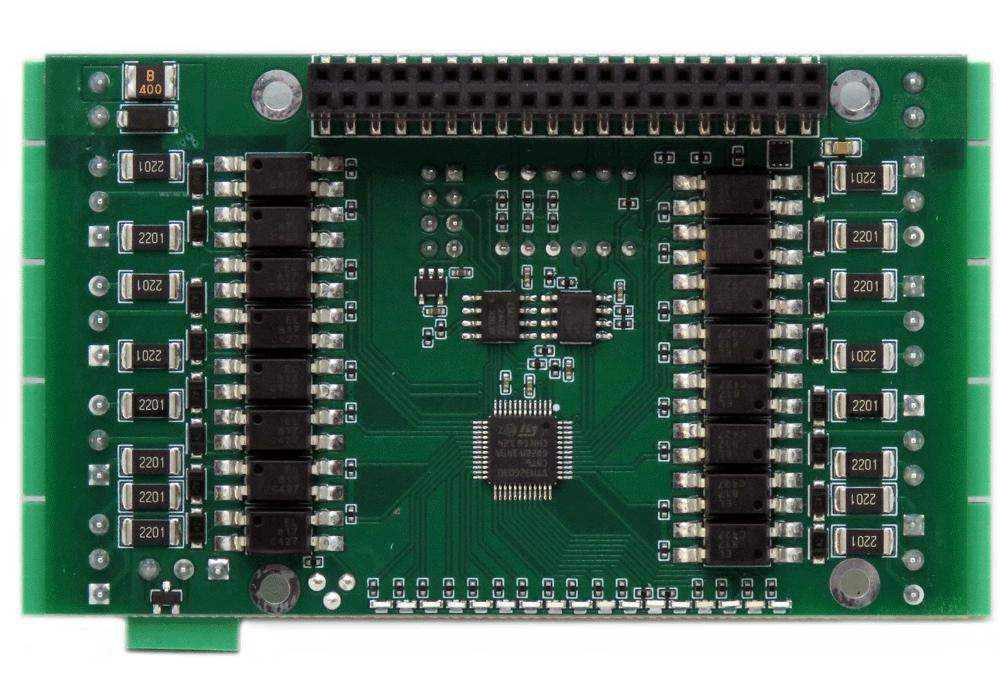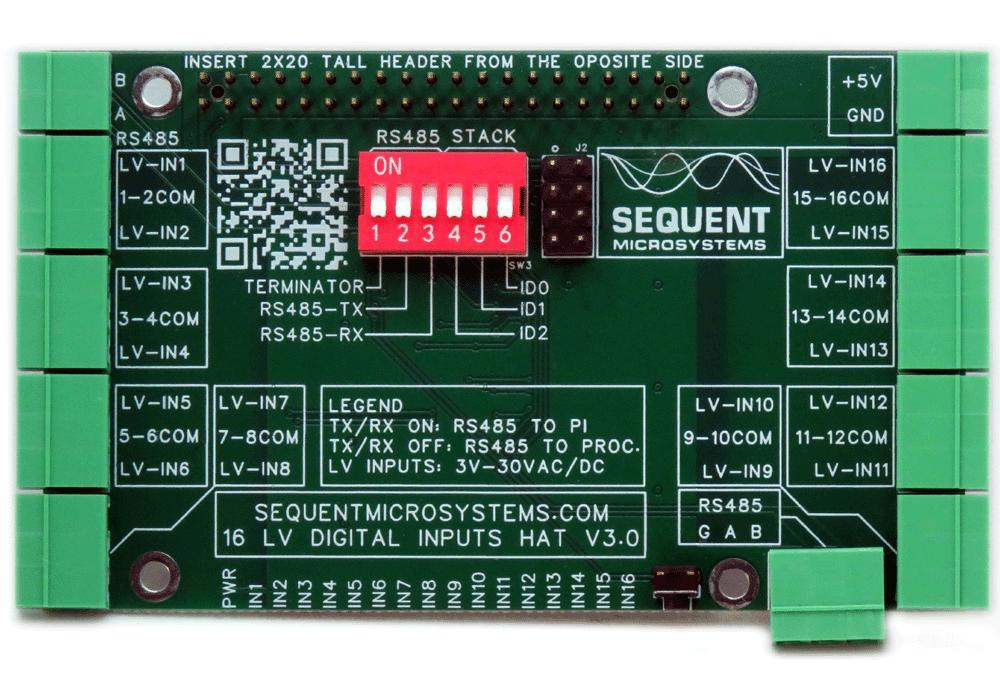
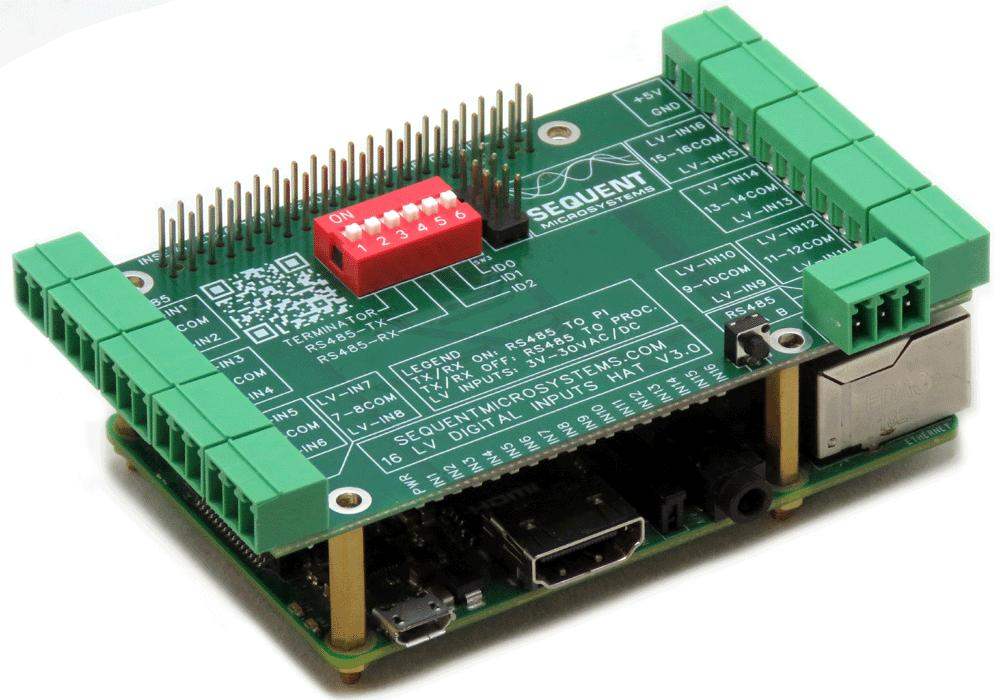
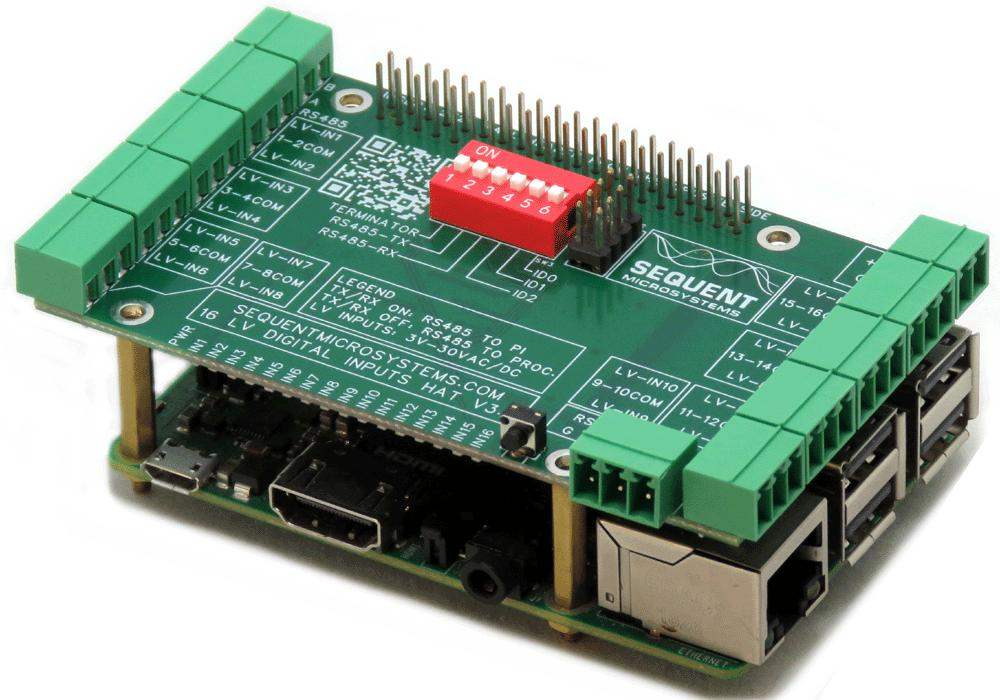
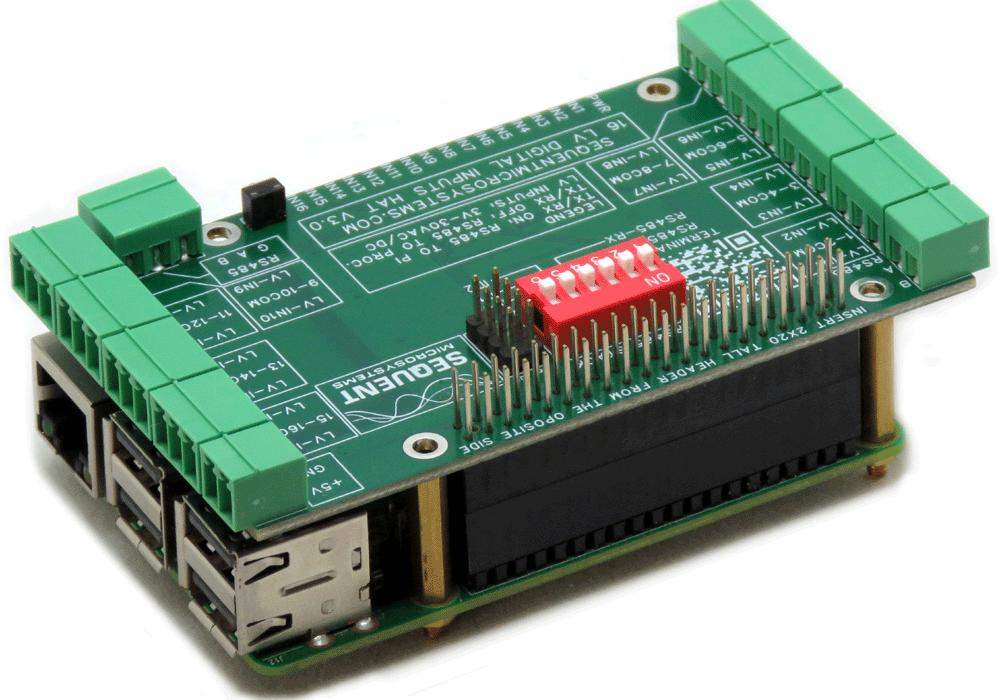
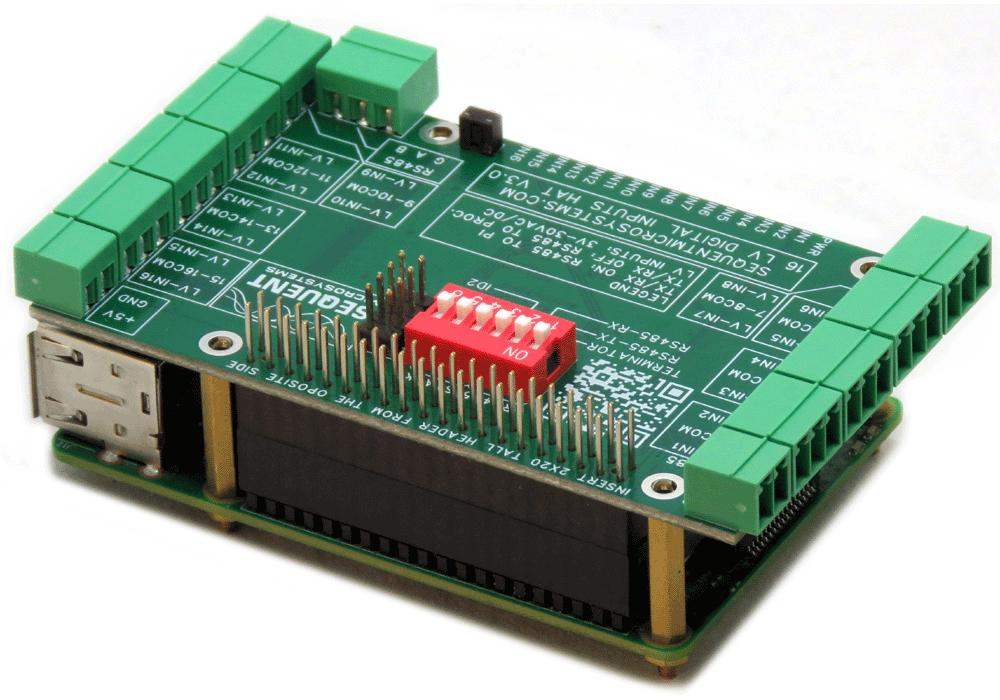
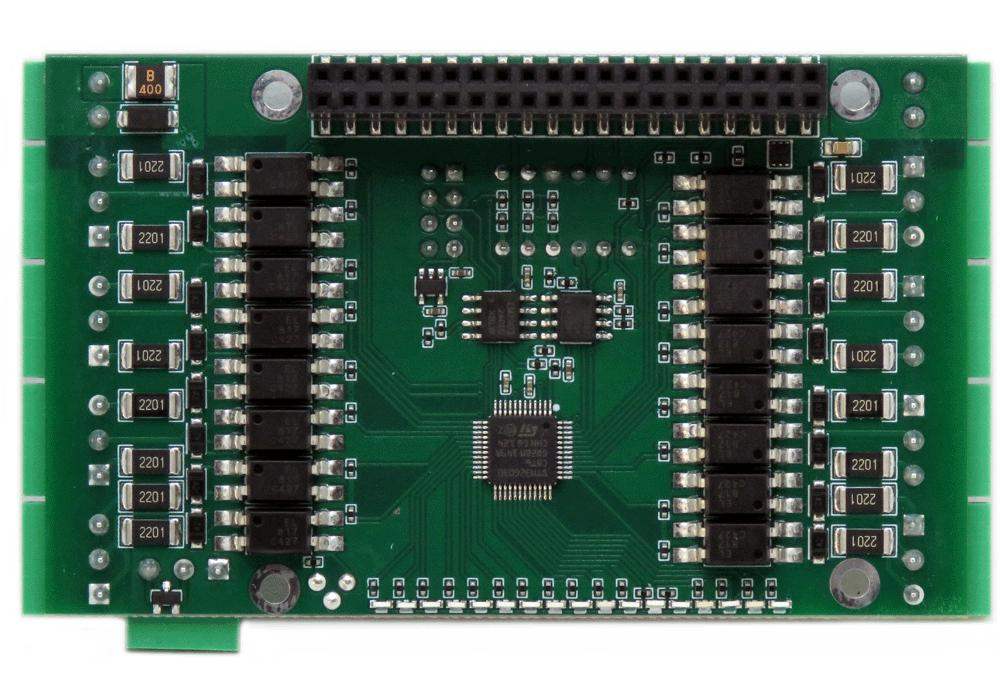
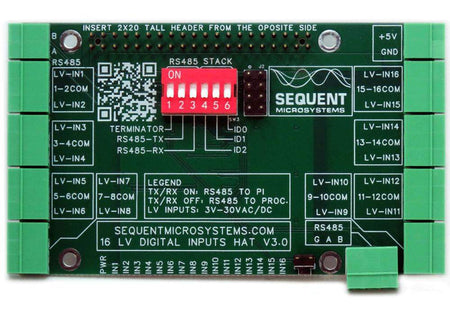
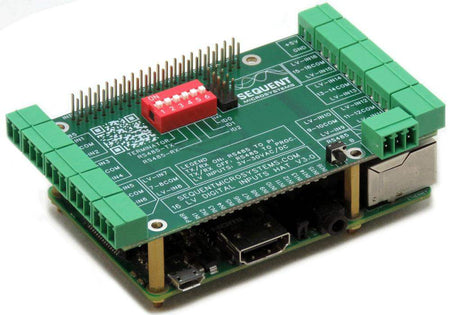
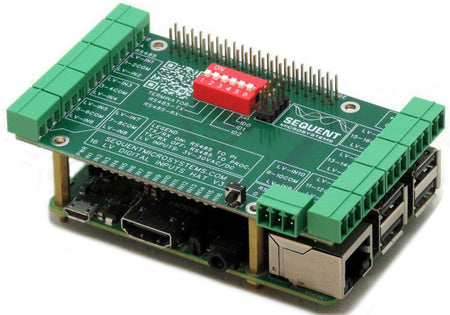
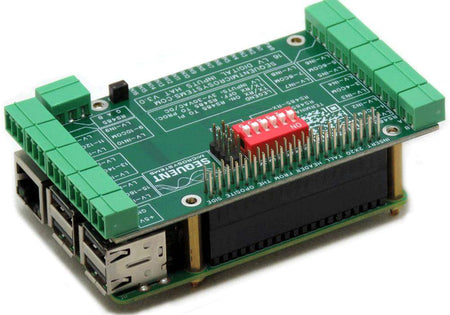
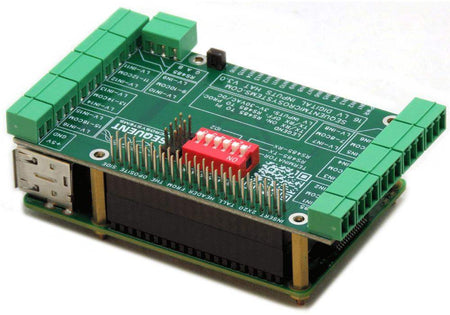
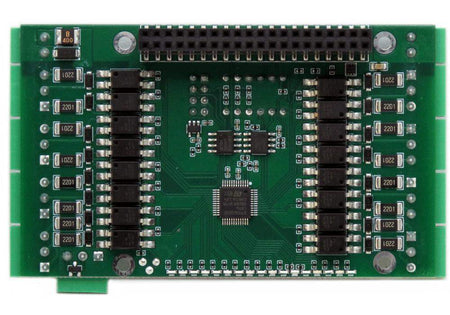
Sixteen LV Digital Inputs 8-Layer Stackable HAT for Raspberry Pi
Sixteen 3V-48V Opto-isolated Inputs with LED indicators; RS485/MODBUS, Hardware Watchdog.
In stock
Regular price
$55.00
Add sixteen 3–48 V AC/DC opto-isolated digital inputs to any Raspberry Pi (Zero–5) with this 8-layer stackable HAT. Per-channel range selection, LED status on every input, RS485/MODBUS with a local processor and hardware watchdog, and interrupt-on-change support make the Sixteen LV Digital Inputs Card reliable for industrial/building signals—using only I²C so GPIOs stay free and scaling to 128 inputs with stacking.
FEATURES
- NEW FEATURES IN VERSION 3:
- *NEW*: Local processor permits standalone operation (no Raspberry Pi)
- *NEW*: Hardware watchdog resets Raspberry Pi in case of software lockup
- *NEW*: 3 PIN RS385 Connector
- *NEW*: 8 extra LEDs (total 16 LEDs, one for each input)
- *NEW*: DIP Switch Stack Level and RS485 selection (no more jumpers)
- Inputs can be accessed from any PLC using RS485/MODBUS
- All inputs opto-isolated reading 3V-48V AC/DC
- Eight layer stackable to 128 inputs
- Can interrupt Raspberry Pi on any change of input (no need for polling)
- Pluggable Connectors 26-16 AWG wires
- RS485/MODBUS port
- 16 LEDs showing status of each input
-
General purpose push-button
- Uses only I2C port, all GPIO pins available
- Works with any Raspberry Pi from ZERO to 5
- ECCN Code EAR99
- Operating temperature range: -40 to +85 °C
- Storage temperature range: –65 to +150 °C
- Command Line Driver
- Python Library
- Node-Red nodes
- CODESYS Driver
- OpenPLC module
- CODESYS Library
- Home Assistant Integration
DESCRIPTION
Raspberry Pi can read 26 Input signals through the GPIO header, but sometimes you might need to read more. Since all GPIO pins are wired directly to the local processor, some hardware is required to connect them to the real world.
The Sixteen LV Digital Inputs Card has 16 optically isolated Digital Inputs. Input ranges can be jumper-selected for each channel, from 3 volts to 48 volts. Digital Inputs can read both DC and AC signals. The card communicates with Raspberry Pi using only the I2C port, leaving all the other 24 GPIO pins available for your use. It has also an RS-485 port, a power LED and a push button that can be used to shut down the Raspberry Pi. Pluggable connectors make the 16-INPUTS card easy to use when multiple cards are stacked up.
COMPATIBILITY
The card is compatible with all Raspberry Pi versions from Zero to 5. All stacked cards share the I2C bus using only two of the Raspberry Pi’s GPIO pins to manage all eight cards. This feature leaves the remaining 24 GPIOs available for the user.
POWER REQUIREMENTS
The Sixteen LV Digital Inputs card needs 5V to operate and can be powered from Raspberry Pi or from it's own 2 pin pluggable connector. The card draws 10mA. If power is applied to the 2 pin pluggable connector, no other power supply is needed for the Raspberry Pi.
LED INDICATORS
A power LED shows when power is applied to the board. Sixteen LEDs show the status of the inputs.
STACKING MULTIPLE CARDS
Up to eight Sixteen LV Digital Inputs cards can be stacked on your Raspberry Pi. Three positions of the configuration DIP Switch labeled ID0, ID1, ID2 are used to select the stack level. Cards can be stacked in any order.
RESET PUSHBUTTON
Shutting down the Raspberry Pi by turning off the power can result in SD Card failure. To prevent this, a shutdown command needs to be used before power cut-off. But this requires a monitor, keyboard and mouse connected to the Pi.
A momentary on push button installed at the edge of the Sixteen LV Digital Inputs card provides a convenient way to shut down the Raspberry Pi. The button is routed to pin 37 (GPIO 26). You need to write a script which monitors this pin, and if pressed for more than a desired time, issues the shut-down command.
RS485 PORT
An RS485 transceiver enables the Raspberry Pi to connect to other industrial sensors or actuators. In order to use the RS485 port, a jumper needs to be installed on the RXD line going to Raspberry Pi. The jumper is marked RS485 in the layout below. If the jumper is not installed, the RXD line from Raspberry Pi can be used as GPIO.
CARD LAYOUT

ELECTRICAL SPECIFICATIONS
- Power Supply: 5V/8A pluggable connector with reverse polarity protection
- On board resettable fuse: 3A
- Opto-isolated Digital Inputs:
- Input Forward Current: Typical 5 mA, maximum 50 mA
-
Low Voltage Input Series Resistor: 2.2K
- Isolation Voltage between inputs and ground: 5,000Vrms
MECHANICAL SPECIFICATIONS

DOWNLOADS
SOFTWARE
SOFTWARE INTERFACES
You can write your own application using the Command Line or Python Library provided. No programming is required if you use the Node-Red nodes we supply. You can drag-and-drop the functional blocks to design your application. Examples are provided at GitHub.
RS485 port
A standard RS485 transceiver permits the Raspberry Pi to communicate using any protocol including MODBUS, PROFIBUS, camera PTZ control, etc. The transceiver is connected to the serial port of the Raspberry Pi from the GPIO connector, pins 8 (GPIO14, TxD0) and 10 (GPIO15, RxD0). The Rx line is routed through a 2 pin jumper. The jumper needs to be installed in order to use the RS485 port. If the jumper is not installed, both pins can be used as GPIO's
ACCESSORIES
DIN-RAIL MOUNTING
The card can be installed parallel on a DIN-Rail using the DIN-Rail Kit Type 1, or perpendicular using the DIN-Rail Kit Type 2. Shown here is a perpendicular installation which can be expanded to 8 cards.

YOUR KIT
When you purchase the card you will receive the following items:
1. Sixteen LV Digital Inputs Card for Raspberry Pi

2. Mounting hardware
- Four M2.5x18mm male-female brass standoffs
- Four M2.5x5mm brass screws
- Four M2.5 brass nuts

4. Mating connector plugs

QUICK START
- Plug your card on top of your Raspberry Pi and power up the system.
- Enable I2C communication on Raspberry Pi using raspi-config.
- Install the card software from github.com:
- ~$ git clone https://github.com/SequentMicrosystems/16inpind-rpi.git
- ~$ cd /home/pi/16inpind-rpi
- ~/16inpind-rpi$ sudo make install
-
~/16inpind-rpi$ 16inpind -h
The program will respond with a list of available commands.
Related products
-
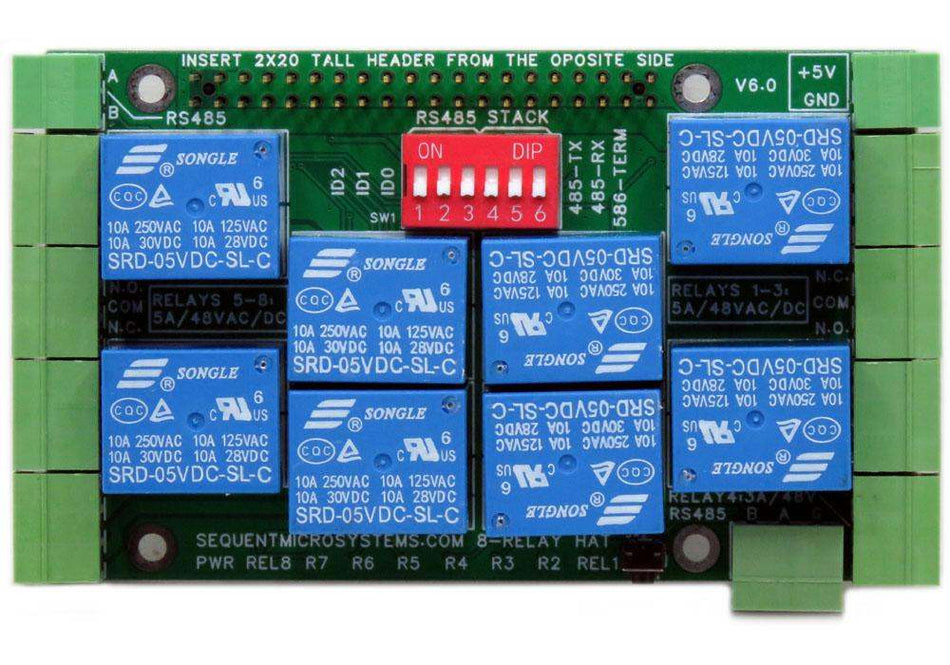 In stock
In stockEight Relays 4A/120V 8-Layer Stackable HAT for Raspberry Pi
Eight Relays 4A/120VAC, 24VDC N.O./N.C. contacts and LED indicators; RS485 Port. -
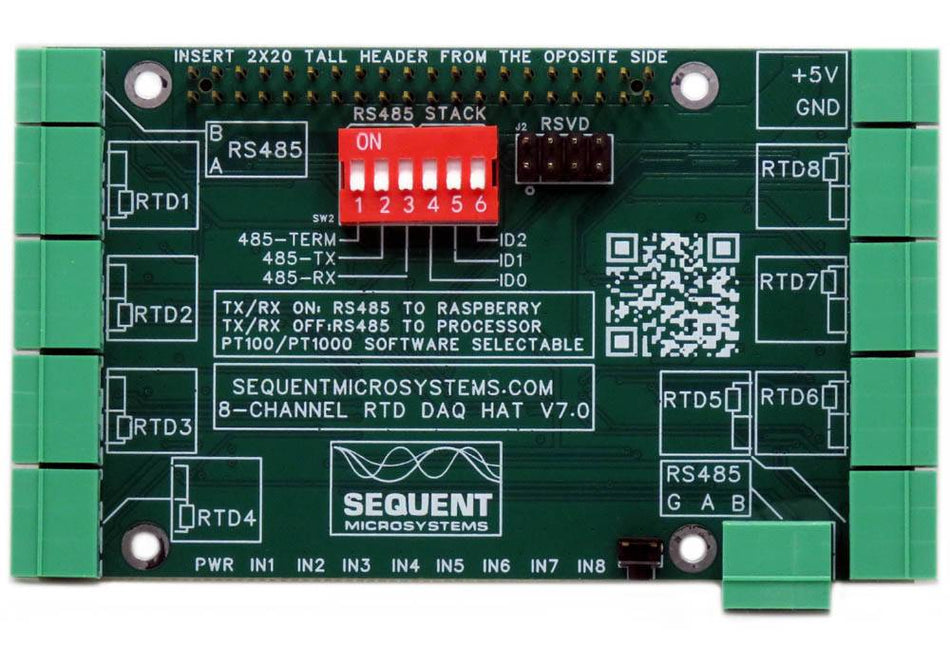 In stock
In stockRTD Data Acquisition 8-Layer Stackable HAT for Raspberry Pi
Eight Channel RTD Data Aquisition HAT; 0.01% accuracy through calibration; PT100/1000 Sensors; RS485/MODBUS, Watchdog. -
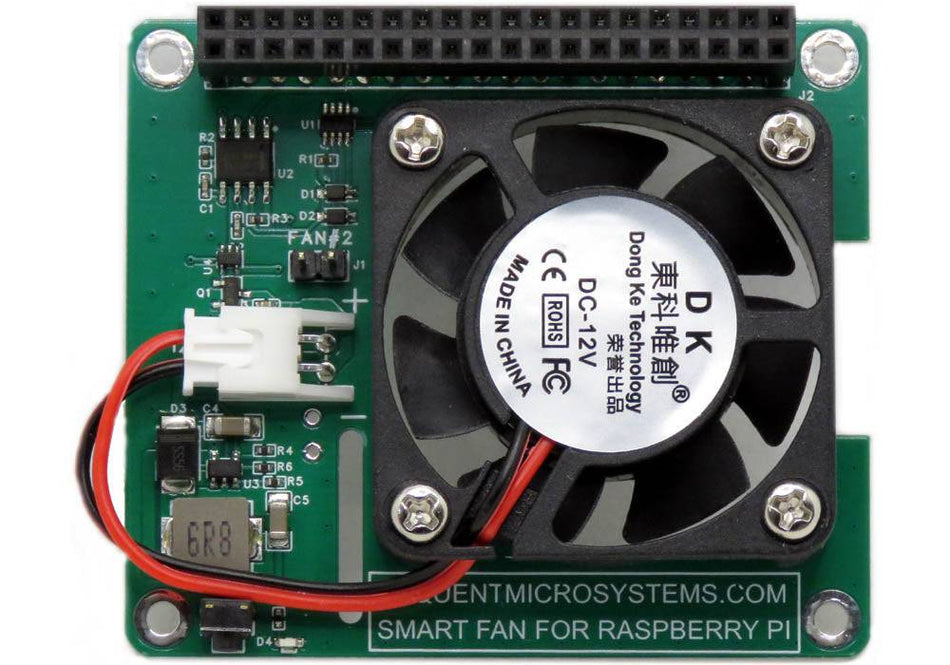 Coming soon
Coming soonSmart Fan HAT the Best Cooling Solution for Raspberry Pi
PWM controlled 40x40x10mm Fan keeps Raspberry Pi temperature constant; Stackable with any other HAT. -
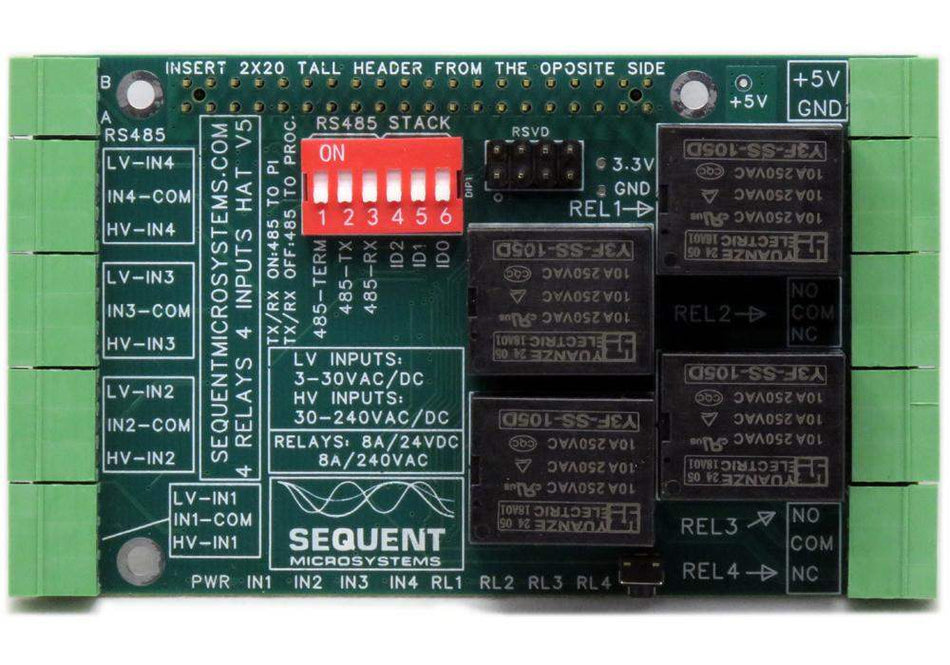 In stock
In stockFour Relays four HV Inputs 8-Layer Stackable HAT for Raspberry Pi
Four Relays 8A/240VAC; Four opto-isolated Inputs 3V-240V; RS485/MODBUS; Quadrature encoder, PPS counters, PWM inputs;

